Mapping the Decay Hazard of Wooden Structures in Topographically Divergent Regions
Abstract
1. Introduction
2. Materials and Methods
2.1. Investigation Areas and Data Source
2.2. Exposure Models
2.3. Scheffer Climate Index (SCI)
2.4. Decay Models
2.4.1. Logistic Dose–Response Model LM
2.4.2. Simplified Logistic Dose–Response Model SLM
2.5. Decay Hazard Mapping
3. Results and Discussion
3.1. Switzerland
3.2. Lötschental
4. Conclusions
- A more detailed analysis of a region with prominent differences in topography, here Switzerland, shows their impact on decay dosage as determined on macro climate data. The higher the differences in topography, and the smaller the area on which they occur, the higher the resolution required for decay hazard mapping to adequately consider the local climate.
- Small-scale differences of climate-induced decay dose can be significant and may lead to a reduction of service lives up to a factor of 1.5, as shown for the mountainous region at Lötschental at distances of less than 40 km.
- The combination of exposure and decay models determines to what extent topography-affected climate parameters, i.e., mainly temperature, lead to deviations of decay dose on small scale. The closer meshed the grid of climate data points is for dose modelling, the more accurate the decay hazard can be predicted.
- Future work should concentrate on the validation and optimization of service life prediction models. Based on the findings from this study the response in terms of fungal decay in wood on local and micro-climatic conditions is model specific. Hence, field test data need to be considered for validation which reflect also climatic differences on a spatial small scale. High resolution hazard mapping should be done also for other regions to further improve the understanding of impact factors such as topography, water bodies, and the concentration of settlements in urban areas.
- Furthermore, in this study the moisture-induced risk has been modelled material independent, but for service life prediction, the material-specific moisture performance needs to be considered as well; e.g., in terms of the moisture exclusion efficiency of differently treated and modified wood. However, the climate-induced decay hazard remains unaffected by the material of choice; solely, the material resistance may change.
Author Contributions
Funding
Acknowledgments
Conflicts of Interest
References
- Brischke, C.; Thelandersson, S. Modelling the outdoor performance of wood products–A review on existing approaches. Constr. Build. Mat. 2014, 66, 384–397. [Google Scholar] [CrossRef]
- Scheffer, T.C. A climate index for estimating the potential for decay in wood structures above ground. For. Prod. J. 1971, 21, 25–31. [Google Scholar]
- Setliff, E.C. Wood decay hazard in Canada based on Scheffer’s climate index formula. For. Chron. 1986, 456–459. [Google Scholar] [CrossRef]
- Morris, P.I.; McFarling, S.; Wang, J. A new decay hazard map for North America using the Scheffer Index. In Proceedings of the IRG Americas Regional Meeting, Playa Flamingo, Guanacaste, Costa Rica, 30 November–2 December 2008; 14p. IRG/WP 08–10672. [Google Scholar]
- Kim, T.; Ra, J.B. Change of decay hazard index (Scheffer index) for exterior above-ground wood in Korea. J. Kor. Wood Sci. Technol. 2014, 42, 732–739. [Google Scholar] [CrossRef][Green Version]
- Kim, T.G.; Ra, J.B.; Kang, S.M.; Wang, J. Determination of decay hazard index (Scheffer index) in Korea for exterior above-ground wood. J. Kor. Wood Sci. Technol. 2011, 39, 531–537. [Google Scholar] [CrossRef]
- Wang, J.; Wu, X.; Jiang, M.; Morris, P.I. Decay hazard classification in China for exterior above-ground wood. In Proceedings of the IRG Annual Meeting, Jackson Lake Lodge, WY, USA, 20–24 May 2007; 10p. IRG/WP 07-20357. [Google Scholar]
- Hasegawa, M. Relationships between wood protection and climate indexes. Mokuzai Hozon 1996, 22, 2–9. [Google Scholar]
- Wang, C.-H.; Leicester, R.H.; Nguyen, M.N. Decay Above Ground. Manual No. 4; CSIRO Sustainable Ecosystems, Urban Systems Program: Highett, Australia, 2008. [Google Scholar]
- Lisø, K.R.; Hygen, H.O.; Kvande, T.; Thue, J.V. Decay potential in wood structures using climate data. Build. Res. Inf. 2006, 34, 546–551. [Google Scholar] [CrossRef]
- Fernandez-Golfin, J.; Larrumbide, E.; Ruano, A.; Galvan, J.; Conde, M. Wood decay hazard in Spain using the Scheffer index: Proposal for an improvement. Eur. J. Wood Wood Prod. 2016, 74, 591–599. [Google Scholar] [CrossRef]
- Nikolitsa, G.; Giarma, C. Estimation of decay potential of wooden elements above ground in Greece. Build. Environ. 2019, 154, 155–166. [Google Scholar] [CrossRef]
- Niklewski, J.; Frühwald-Hansson, E.; Brischke, C.; Kavurmaci, D. Development of decay hazard maps based on decay prediction models. In Proceedings of the IRG Annual Meeting, Lisbon, Portugal, 15–19 May 2016; 15p. IRG/WP 16-20588. [Google Scholar]
- Brischke, C.; Frühwald Hansson, E.; Kavurmaci, D.; Thelandersson, S. Decay hazard mapping for Europe. In Proceedings of the IRG Annual Meeting, Queenstown, New Zealand, 8–12 May 2011; 20p. IRG/WP 11-20463. [Google Scholar]
- Niklewski, J.; Brischke, C.; Frühwald Hansson, E. Numerical study on the effects of macro climate and detailing on the relative decay hazard of Norway spruce. Wood Mat. Sci. Eng. 2019, 1–9. [Google Scholar] [CrossRef]
- Carll, C.G. Decay Hazard (Scheffer) Index Values Calculated from 1971–2000 Climate Normal Data; General Technical report FPL-GTR-179; United States Department of Agriculture, Forest Service, Forest Products Laboratory: Madison, WI, USA, 2009. [Google Scholar]
- De Groot, R.C. An Assessment Climate Index in Predicting Wood Decay in Houses. Durab. Build. Mat. 1982, 1, 169–174. [Google Scholar]
- Norén, J. Assessment and Mapping of Environmental Degradation Factors in Outdoor Applications. Ph.D. Thesis, KTH Stockholm, Stockholm, Sweden, 2001. [Google Scholar]
- Brischke, C.; Rapp, A.O.; Bayerbach, R. Decay influencing factors: A basis for service life prediction of wood and wood-based products. Wood Mat. Sci. Eng. 2006, 1, 91–107. [Google Scholar] [CrossRef]
- Brischke, C.; Rapp, A.O. Dose–response relationships between wood moisture content, wood temperature and fungal decay determined for 23 European field test sites. Wood Sci. Technol. 2008, 42, 507–518. [Google Scholar] [CrossRef]
- Larkin, G.M.; Laks, P.E. To decay or not to decay: An accelerated field test of the validity of the Scheffer Index. In Proceedings of the IRG Americas Regional Meeting, Playa Flamingo, Guanacaste, Costa Rica, 30 November–2 December 2008; 15p. IRG/WP 08-20392. [Google Scholar]
- Morris, P.I.; Wang, J. Scheffer index as preferred method to define decay risk zones for above ground wood in building codes. Int. Wood Prod. J. 2011, 2, 67–70. [Google Scholar] [CrossRef]
- Cornick, S.; Dalgliesh, W.A. A moisture index to characterize climates for building envelope design. J. Therm. Envel. Build. Sci. 2003, 27, 151–178. [Google Scholar] [CrossRef]
- Lebow, S.T.; Highley, T. Regional biodeterioration hazards in the United States. In Development of Commercial Wood Preservatives: Efficacy, Environmental, and Health Issues; Schultz, T.P., Militz, H., Freeman, M.H., Goodell, B., Nicholas, D.D., Eds.; ACS Symposium Series; American Chemical Society: Washington, DC, USA, 2008; Volume 982, pp. 120–141. [Google Scholar]
- Lebow, P.K.; Carll, C.G. Investigation of shift in decay hazard (Scheffer) index values over the period 1969-2008 in the conterminous United States. In Proceedings of the 106th Annual Meeting American Wood Protection Association, Hyatt Regency Riverfront, Savannah, GA, USA, 23–25 May 2010; Volume 106, pp. 118–125. [Google Scholar]
- Momohara, I.; Ota, Y.; Yamaguchi, T.; Ishihara, M.; Takahata, Y.; Kosaka, H. Assessment of the decay risk of airborne wood-decay fungi III: Decay risks at different sampling sites. J. Wood Sci. 2013, 59, 442–447. [Google Scholar] [CrossRef]
- Beesley, J.; Crefffield, J.W.; Saunders, I.W. An Australian test for decay in painted timbers exposed to the weather. For. Prod. J. 1983, 33, 57–63. [Google Scholar]
- Cornick, S.; Djebbar, R.; Dalgliesh, W. Selecting moisture reference years using a moisture index approach. Build. Environ. 2003, 38, 1367–1379. [Google Scholar] [CrossRef]
- Creemers, J.; de Meijer, M.; Zimmermann, T.; Sell, J. Influence of climatic factors on the weathering of coated wood. Holz als Roh-und Werkstoff 2002, 60, 411–420. [Google Scholar] [CrossRef]
- Grinda, M.; Carey, J. The Cost Euro Index for fungal decay–Five years results. In Proceedings of the COST Action E22-Environmental Optimisation of Wood Protection (EUR 22597), Estoril, Portugal, 22–23 March 2004. [Google Scholar]
- Thelandersson, S.; Isaksson, T.; Frühwald Hansson, E.; Toratti, T.; Viitanen, H.; Grüll, G.; Jermer, J.; Suttie, E. Service Life of Wood in Outdoor Above Ground Applications–Engineering Design Guideline; Report TVBK-3060, Lund University, SP Report 2011:15 WoodWisdom project ‘WoodExter’; Lund University: Lund, Sweden, 2011. [Google Scholar]
- Isaksson, T.; Thelandersson, S. Experimental investigation on the effect of detail design on wood moisture content in outdoor above ground applications. Build. Environ. 2013, 59, 239–249. [Google Scholar] [CrossRef]
- Viitanen, H.; Toratti, T.; Makkonen, L.; Peuhkuri, R.; Ojanen, T.; Ruokolainen, L.; Räisänen, J. Towards modelling of decay risk of wooden materials. Eur. J. Wood Wood Prod. 2010, 68, 303–313. [Google Scholar] [CrossRef]
- Viitanen, H.; Ritschkoff, A.-C. Brown Rot Decay in Wooden Constructions. Effect of Temperature, Humidity and Moisture; Report no. 222; Swedish University of Agricultural Sciences, Department of Forest Products: Uppsala, Sweden, 1991. [Google Scholar]
- Viitanen, H. Factors Affecting the Development of Mould and Brown Rot Decay in Wooden Material and Wooden Structures. Effect of Humidity, Temperature and Exposure Time. Ph.D. Thesis, University of Uppsala, Uppsala, Sweden, 1996. [Google Scholar]
- Viitanen, H. Critical time of different humidity and temperature conditions for the development of brown rot decay in pine and spruce. Holzforschung 1997, 51, 99–106. [Google Scholar] [CrossRef]
- Toratti, T.; Viitanen, H.; Peuhkuri, R.; Makkonen, L.; Ojanen, T.; Jämsä, S. Modelling of durability of wooden structures. In Proceedings of the 4th International Building Physics Conference, Istanbul, Turkey, 15–18 June 2009; pp. 127–134. [Google Scholar]
- Brischke, C.; Meyer-Veltrup, L. Modelling timber decay caused by brown rot fungi. Mat. Struct. 2016, 49, 3281–3291. [Google Scholar] [CrossRef]
- EN 252. Field Test Method for Determining the Relative Protective Effectiveness of a Wood Preservative in Ground Contact; CEN-European Committee for Standardization: Brussels, Belgium, 2015. [Google Scholar]
- Meyer-Veltrup, L.; Brischke, C.; Niklewski, J.; Frühwald Hansson, E. Design and performance prediction of timber bridges based on a factorization approach. Wood Mat. Sci. Eng. 2018, 13, 167–173. [Google Scholar] [CrossRef]
- Google Earth, Version 7.1.2.2041, © 2020, Google, Iamge © 2020 GeoBasis-DE/BKG Image Landsat/Copernicus. Available online: https://earth.google.com/web/@46.73197863,8.68630646,2479.98660966a,508044.67111453d,35y,0h,0t,0r (accessed on 28 April 2020).
- Google Earth, Version 7.1.2.2041, © 2020, Google, Image © 2020 Flotron/Perrinjaquet, © 2020 DigitalGlobe. Available online: https://earth.google.com/web/@46.33924546,7.61796499,1184.90795355a,139994.77684591d,35y,0h,0t,0r (accessed on 28 April 2020).
- Frühwald Hansson, E.; Brischke, C.; Meyer, L.; Isaksson, T.; Thelandersson, S.; Kavurmaci, D. Durability of timber outdoor structures–Modelling performance and climate impacts. In Proceedings of the World Conference on Timber Engineering, Auckland, New Zealand, 16–19 July 2012. [Google Scholar]
- Meteonorm. Meteonorm Handbook Part II: Theory. 2018. Available online: https://meteonorm.com/assets/downloads/mn73_theory.pdf (accessed on 28 April 2020).
- Tveit, A. Measurements of Sorption and Moisture Permeability of Porous Material; Report UDC 532.685; Norwegian Building Research Institute: Oslo, Norway, 1966. [Google Scholar]
- Van den Bulcke, J.; Van Acker, J.; De Smet, J. An experimental set-up for real-time continuous moisture measurements of plywood exposed to outdoor climate. Build. Environ. 2009, 44, 2368–2377. [Google Scholar] [CrossRef][Green Version]
- Francis, L.P.; Norton, J.; Melcher, E.; Wong, A.H.H.; Kok Lai, J.; Klamer, M.; Konkler, M.J.; Morrell, J.J. Performance of untreated timbers in above ground decking tests: Preliminary results from an international collaborative trial. In Proceedings of the IRG Annual Meeting, Quebec City, QC, Canada, 12–16 May 2019; 21p. IRG/WP 19-10940. [Google Scholar]
- EN 335. Durability of Wood and Wood-Based Products-Use Classes: Definitions, Application to Solid Wood and Wood-Based Products; CEN-European Committee for Standardization: Brussels, Belgium, 2013. [Google Scholar]
- Emmerich, L.; Brischke, C. 2019: Quantifying the effect of microclimatic parameters on the moisture-induced decay risk of wooden structures. In Proceedings of the IRG Annual Meeting, Quebec City, QC, Canada, 12–16 May 2019; 16p. IRG/WP 19-20649. [Google Scholar]
- Suttie, E.; Brischke, C.; Frühwald Hansson, E.; Fortino, S.; Sandak, J.; Kutnik, M.; Alfredsen, G.; Lucas, C.; Stirling, R. Performance based specification of wood–Introducing project CLICKdesign. In Proceedings of the IRG Annual Meeting, Quebec City, QC, Canada, 12–16 May 2019; 10p. IRG/WP 19-20661. [Google Scholar]
- Brischke, C.; Humar, M.; Niklewski, J.; Alfredsen, G. Modelle zur Vorhersage der Gebrauchsdauer von Holzbauteilen auf dem Prüfstand. Holztechnologie 2019, 60, 23–34. [Google Scholar]
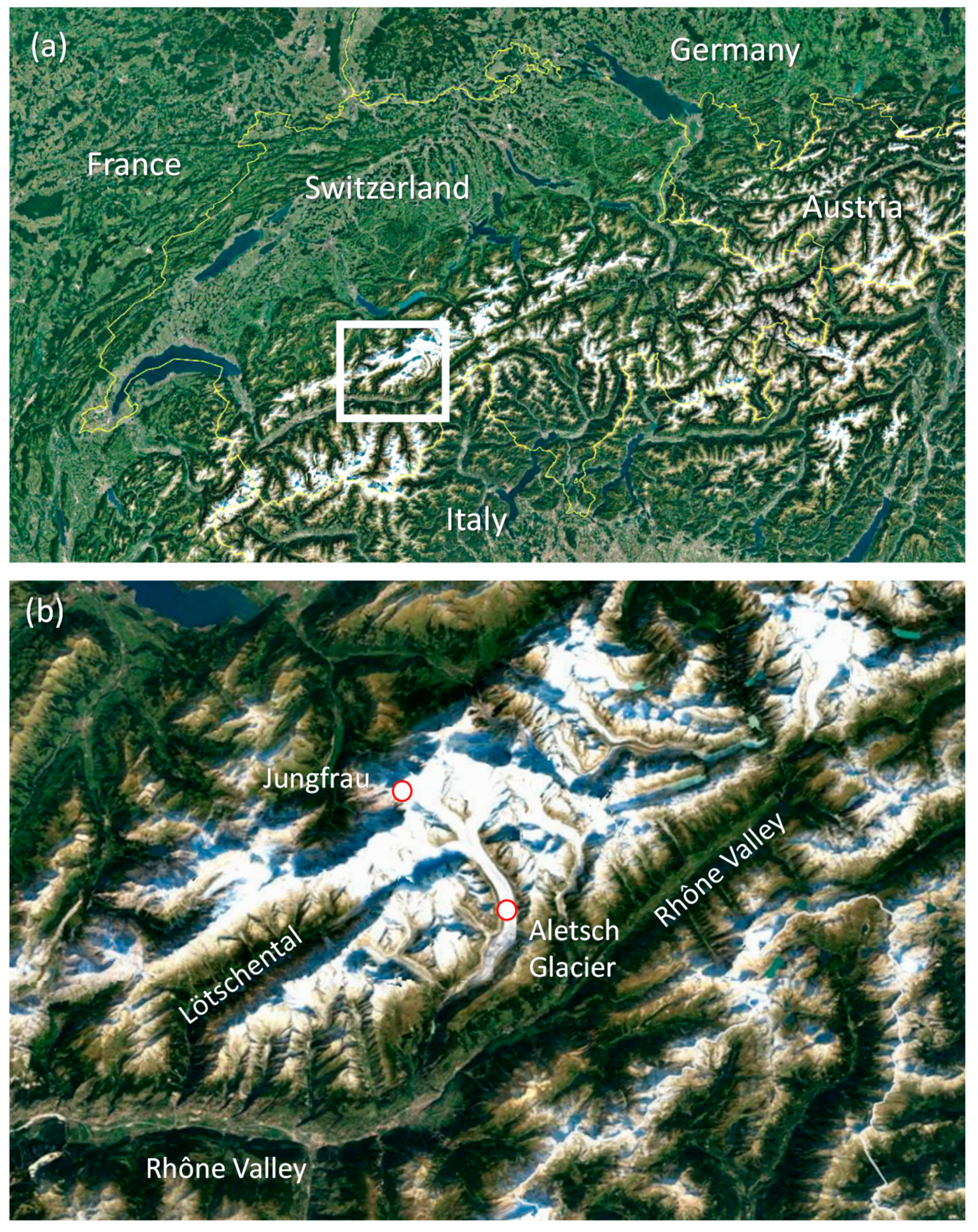
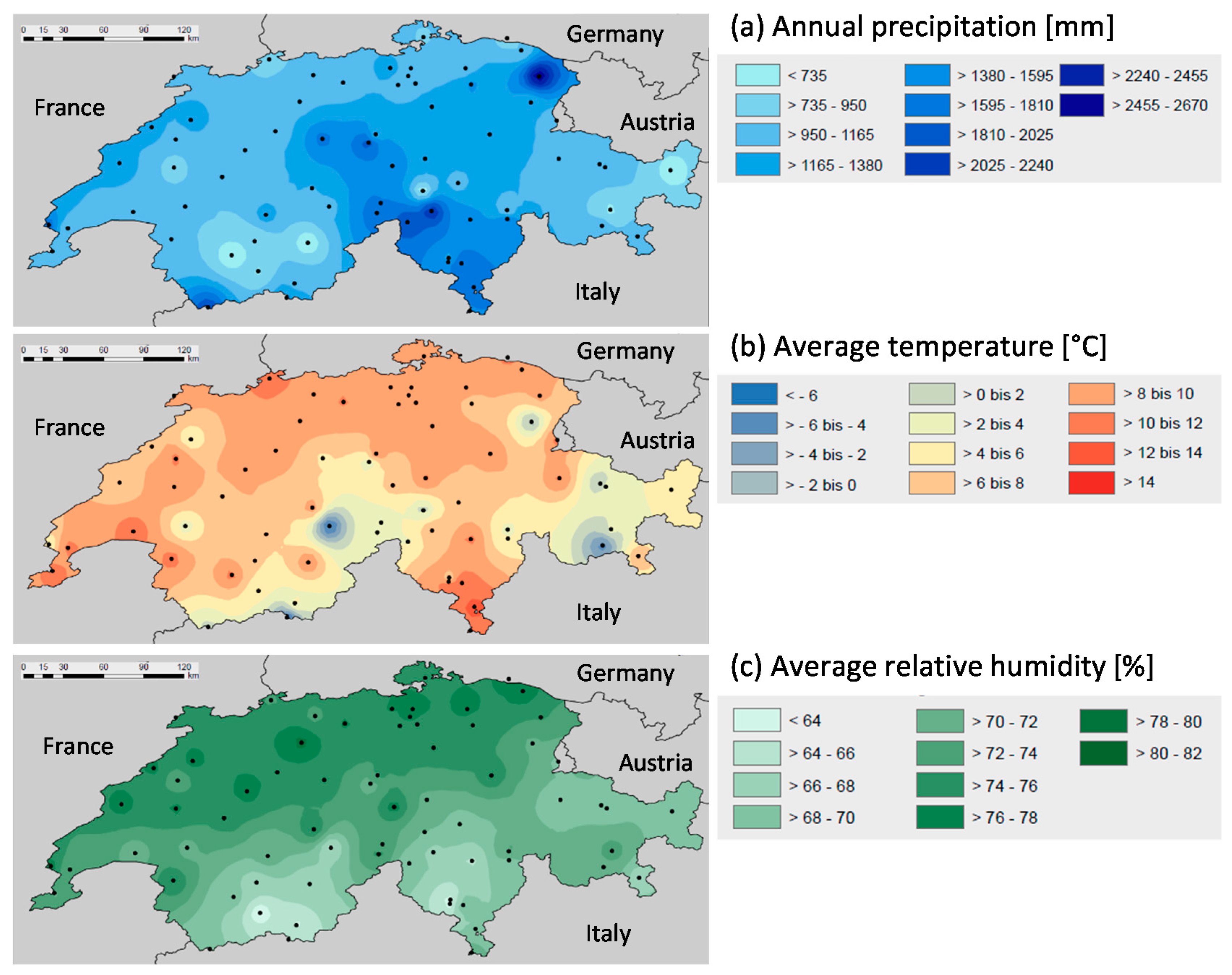
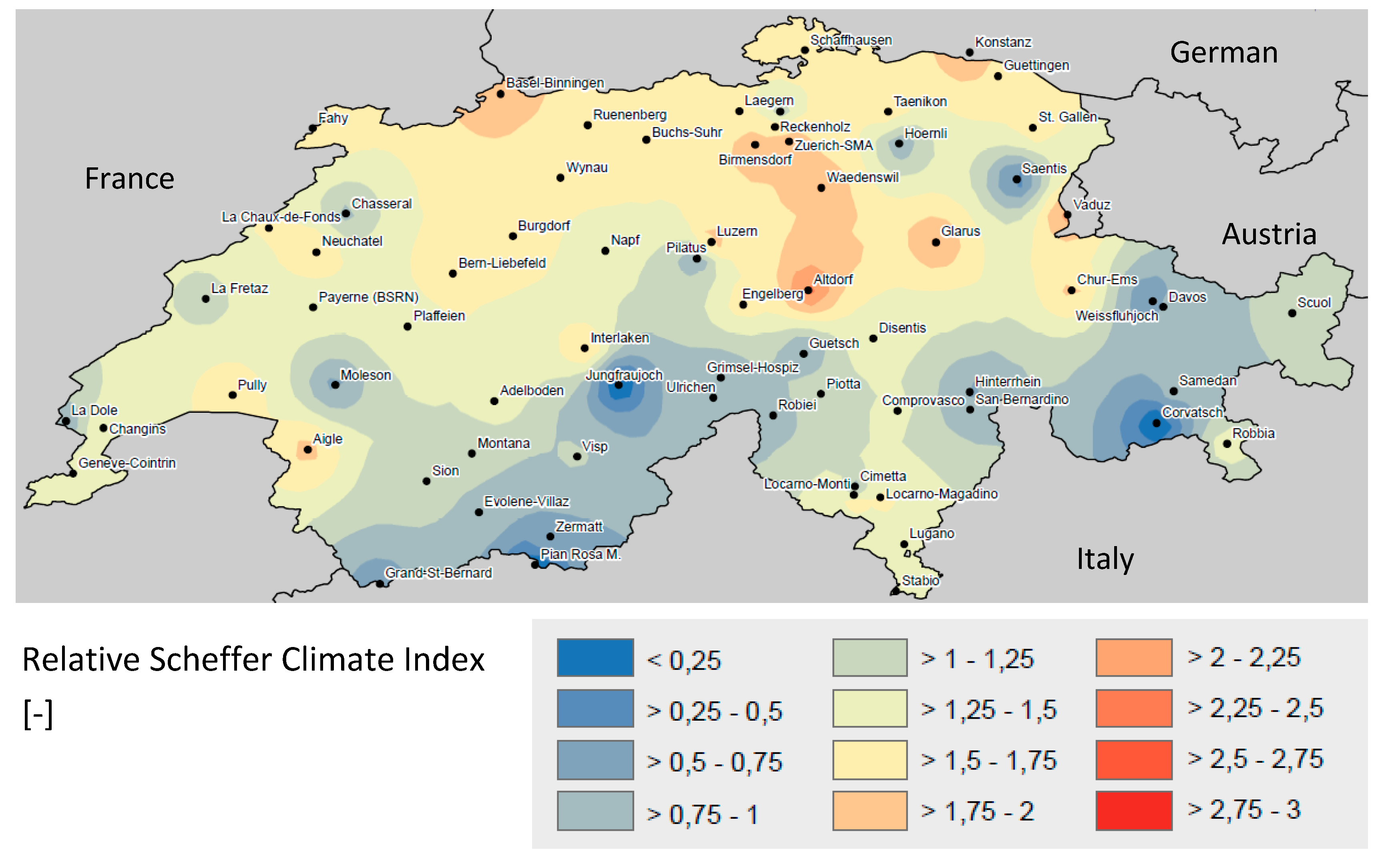
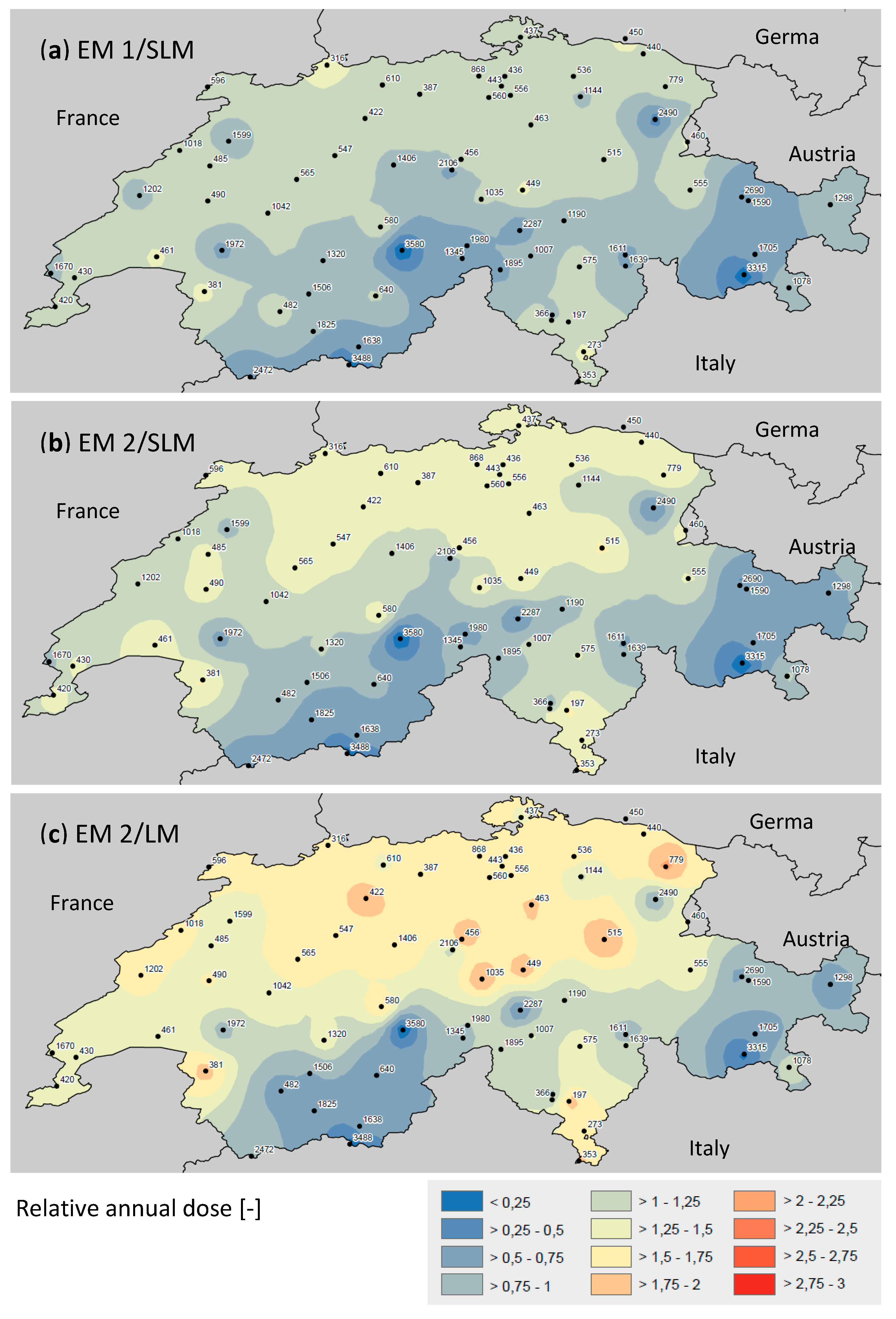

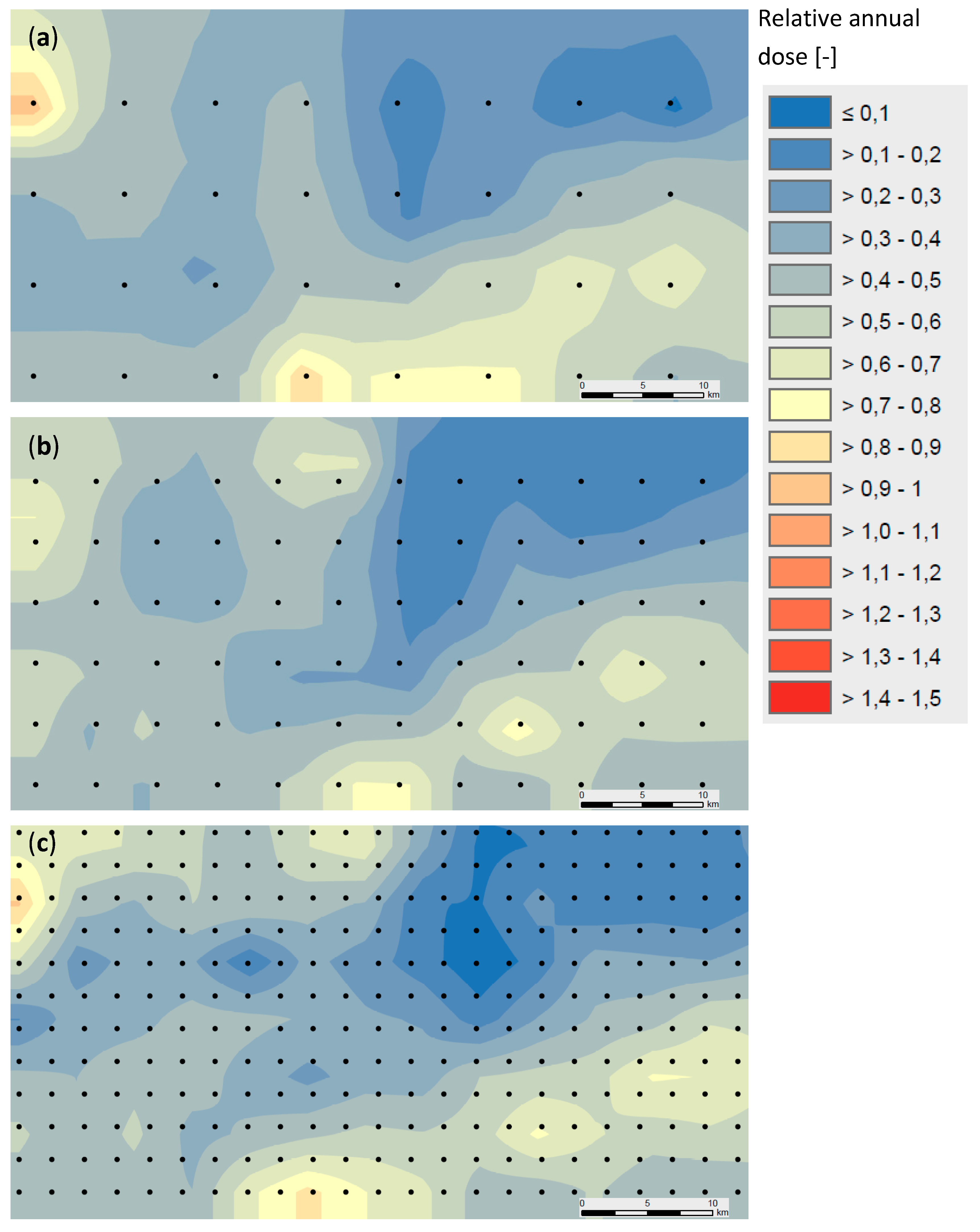
| Parameters | |||
|---|---|---|---|
| a | 3.2 | j | 4.98 |
| e | 6.75·10−10 | k | −1.8·10−6 |
| f | 3.50·10−7 | l | 9.57·10−5 |
| g | 7.18·10−5 | m | −1.55·10−3 |
| h | 7.22·10−3 | n | 0.0417 |
| i | 0.34 | ||
| Relative Dose [-] | ||||
|---|---|---|---|---|
| Parameter | EM 1/SLM | EM 2/LM | EM 2/SLM | SCI 1 |
| Altitude | 0.9953 | 0.5169 | 0.8527 | 0.6893 |
| Precipitation | 0.0313 | 0.0664 | 0.0005 | 0.0121 |
| Avg. RH | 0.1396 | 0.3677 | 0.2317 | 0.1523 |
| Avg. temperature | 0.9547 | 0.4778 | 0.8302 | 0.6671 |
© 2020 by the authors. Licensee MDPI, Basel, Switzerland. This article is an open access article distributed under the terms and conditions of the Creative Commons Attribution (CC BY) license (http://creativecommons.org/licenses/by/4.0/).
Share and Cite
Brischke, C.; Selter, V. Mapping the Decay Hazard of Wooden Structures in Topographically Divergent Regions. Forests 2020, 11, 510. https://doi.org/10.3390/f11050510
Brischke C, Selter V. Mapping the Decay Hazard of Wooden Structures in Topographically Divergent Regions. Forests. 2020; 11(5):510. https://doi.org/10.3390/f11050510
Chicago/Turabian StyleBrischke, Christian, and Vanessa Selter. 2020. "Mapping the Decay Hazard of Wooden Structures in Topographically Divergent Regions" Forests 11, no. 5: 510. https://doi.org/10.3390/f11050510
APA StyleBrischke, C., & Selter, V. (2020). Mapping the Decay Hazard of Wooden Structures in Topographically Divergent Regions. Forests, 11(5), 510. https://doi.org/10.3390/f11050510






